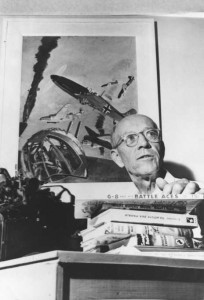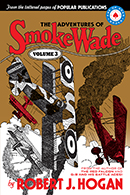Robert J. Hogan
 Robert Jasper Hogan was born in Buskirk, New York on 4 June 1897. The son of a Dutch Reformed Minister, the family name was changed from Van Hoogen. His education began in Schenectady and led through Blair Academy prep school in New Jersey to graduation from St. Lawrence University. In the summer of 1917, he and a friend trekked west to Colorado for some cow-punching and ranch life. The name of that ranch was the G-8.
Robert Jasper Hogan was born in Buskirk, New York on 4 June 1897. The son of a Dutch Reformed Minister, the family name was changed from Van Hoogen. His education began in Schenectady and led through Blair Academy prep school in New Jersey to graduation from St. Lawrence University. In the summer of 1917, he and a friend trekked west to Colorado for some cow-punching and ranch life. The name of that ranch was the G-8.
While in Denver, Hogan was photographed in the newspaper as being the first man in the area to take the new Air Service examination. After enlistment in January 1918, he took ground school at Cornell and was sent to Eberts Field, near the small town of Lonoke, Arkansas, for flight training. Eberts Field was a square mile clearing in the midst of a swampy forest, and the fact that not a single cadet was killed in flight training there was largely due to the surrounding cushion of arborage.
However, Eberts Field did take its toll from the attack of “Spanish” influenza that was scouring Europe and America in late 1918. Approximately 900 of the 1200 personnel were stricken, and Hogan was felled as he was about to go overseas. He recalled afterwards: “Clyde Pangborn (later to become famous as a circus and distance flyer) and I used to stagger down the company street holding each other up and thumbing our noses at the ‘Little Blue Wagon’ with its cargo of fresh corpses inside. After I’d been moved to ‘Self Care’ in Hangar #2, I’d try to ease the coughing bouts by taking a Jenny up, but I’d have to let her fly herself while I bent over and coughed away.”
Discharged after the Armistice, Hogan took post graduate work at Harvard and eventually reentered aviation. The late 1920’s found him a sales manager and airplane demonstrator for the Curtiss-Wright Corp. in Syracuse. Operations manager of that branch office was Harold O. Nevin. While an Air Service squadron commander in France, Nevin had done some intelligence work due to a facility in French acquired during boyhood near the Canadian border. He had picked up the sobriquet “Bull” for his football fame at Syracuse.
Nevin was also a good story-teller and often enthralled the imaginative Hogan with tales of his wartime adventures. When visiting Nevin’s home, Hogan and his wife were both impressed by a photograph on the wall showing three American officers striding abreast along a Paris boulevard. With their Sam Browne belts, boots and swagger sticks, there was an essence of brotherhood and elan that was inspiring, despite the casual agent of war. One of the three was Bull Nevin; and another was named “Nippy” Westover — prototypes of the soon-to-be-created “Bull” Martin and “Nippy†Weston.
Airplane salesmen were expendable after the 1929 collapse, and Hogan soon found himself placed upon his mettle. To fill a leisure moment, he read one of the new aviation pulp magazines. Afterwards, he is reported to have said, “Hell, I can write better than that!” and a short while later he sold his first story to WINGS for $65.00.
Moving from Florida to Manhattan, to be near the pulp markets, he found a jungle of competition. Nearly 300 writers lived around New York and an estimated 1000 others mailed in manuscripts from around the world. Hogan’s main effort was among the half-dozen air story magazines, although he did write sport and western stories to broaden his earning stance. Noting the quality of Popular Publications air magazines, he was determined to become one of their regular writers. In 1932 he succeeded with Smoke Wade.
And so in mid-1933, as he contemplated the proposal to do a book length series, he was quite pleased with his progress in three years. Discussions with Henry Steeger jelled, and a name was sought for the new issue. Reaching back to his ranching days, Hogan suggested “G-8″, principally because “G” had a government and intelligence connotation. Steeger liked that but added “…and his Battle Aces,” the idea being to drop BATTLE ACES, Popular’s first air magazine, and get some carryover identification in the name of its successor….G-8 AND HIS BATTLE ACES.
Bob Hogan’s story formula was for a secret diary of never-before-revealed wartime adventures to be opened to him by a former master spy. There would be an intimacy with high command that hinted at real events, but with the admission that literary license would be freely practiced. Hogan also determined to avoid similarity and dullness with a healthy injection of fantasy.
Using this basic structure, 110 issues were fleshed out with amazing variation in detail for the situational limitations of World War I. The first story, “The Bat Staffel†appeared in September, 1933. Print orders eventually peaked at about 200,00 and things went very well until early 1936 when the price per issue was reduced from 15¢ to 10¢ in an effort to hold circulation. Five years later, the April 1941 issue was the last of the monthly series; thereafter it appeared every two months. The end came with the June 1944 number. The old readership was having their own War; and for the younger, the excitement of daily realities overpowered the antiquity of Spads and Fokkers.
Hogan also wrote a biographic series on two of his friends that had flown in the war. One was William Schauffler who commanded the 90th Aero Squadron with their cocked-dice Salmsons. The other was a Prussian nobleman, Baron von Zastrow. Both men were worked into G-8 novels, adding a little more weight to the premise of a factual diary.
G-8 AND HIS BATTLE ACES became the classic polarization of the air story, because it blended the right ingredients in the correct proportion to intrigue a significant number of people. Other magazines were on the market with novelette, short story, model building, fact-fiction combinations, or a different choice of emphasis in a full-length novel. But the airplane in a written narrative or on the screen can be so poetically spectacular that it becalms the plot mystique and the imagination. The G-8 stories were ground-bound with all its murky mystery, character enrichment, and environmental texture. Airplanes added the third dimension – gave actual flight to the leap of the mind, and a higher proscenium for staging deviltry than the featureless view from a muddy trench. G-8 never quite captured the practical enthusiasts of horsepower and wingspans. It did enthrall the cozy dreamer, many of whom were casual about the world of airplanes. And so this body of early science fiction has become welded to the frame of our mechanistic culture. The formula should be durable. The magic ingredient was Robert J. Hogan.

By Sidney Bradd





